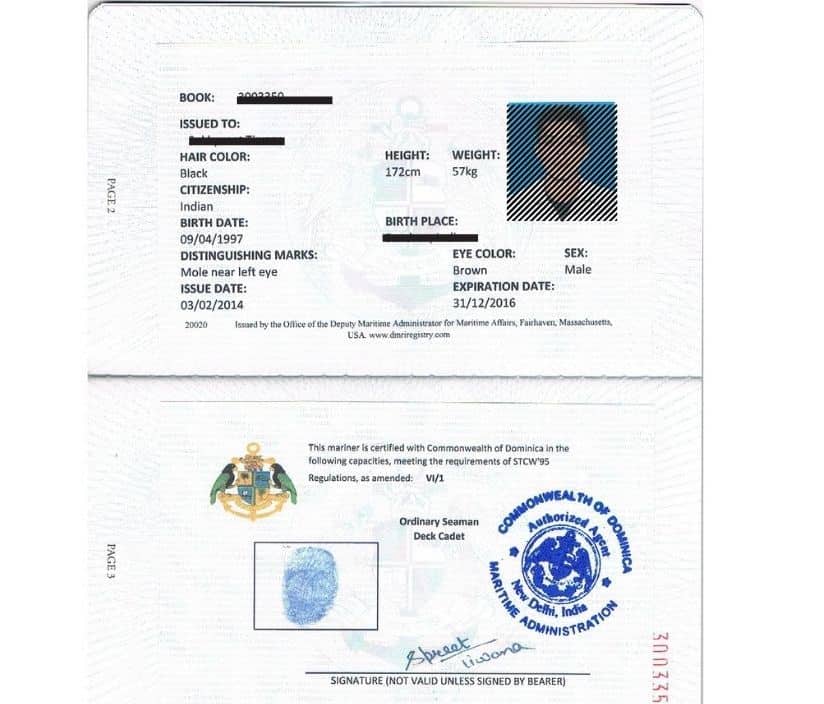What is Seaman’s Service Book?
There are over an estimated 2 million merchant seafarers in active service today. From passenger vessel crew and engineers to tanker ship seamen, there are several types of ships that require different crew qualifications and skills. With the global shipbuilding demand set to grow over the next decade, the scope for seafarers and other naval careers is immense.
During a seaman’s service, they gain experience across a wide spectrum of ships and boats. Each vessel is distinct in its handling and requires the proper experience amongst all its crew members.
A ship operator or charterer cannot afford to hire a relatively unexperienced person for a long or arduous voyage. In such cases, how can the owner judge whether the candidate before them is suitable? There must be some international standardization which can be used to indicate the skill sets of a seaman.
International ships and trading vessels cross the oceans and traverse new countries on a regular basis. If a seaman were to carry a passport with him on every voyage, the entry and exit stamps at each port would easily fill in every page within a very short span of time.
So, if passports are not always a feasible method for checking and providing entry (or exit) to a seafarer, what is the alternative? What could be done so that a seaman would not need to repeatedly take a visa to enter a foreign country he or she regularly sailed to?
And lastly, if there were to be a consolidated source in which the entire details of a seaman were given, who would authorize it, and how would it be obtained? These problems are all addressed by using a “Seaman’s Service Book”.
In this article, we will learn about this booklet and the benefits that come with it. By addressing these individual problems, we will also learn about a very important aspect of any international seafarer’s life- proper and valid documentation.
Seaman’s Service Record or Book
A Seaman’s Service Book (aka Seaman’s Service Record), also known as a Seaman’s Discharge Book, is a comprehensive document in which several details and aspects of the seaman’s professional life are stored. It looks much like a passport and is of the same size, but serves a very different purpose.
As the name suggests, the service record contains details of where, when, how, and which vessel the seafarer has served on.
This information is important not only for an individual’s record, but also for the government, prospective employers, and other members of the maritime industry.
The details are given in the Service Book include:
1. Name of the seafarer with a recent photograph,
2. Age and gender,
3. Identification marks,
4. Nationality and address,
5. Service Book identification number (unique),
6. Date and place of birth,
7. Date of record issuance and expiry,
8. Issuing authority’s name and rank.
The book also includes details such as the seafarer’s employment records. This includes company name, rank, date and reason for discharge. It mentions relevant details about their careers such as voyage summaries, promotion records, visa endorsements, official notices, and vessel skill sets.
The details provided in the Service Book are complete and provide a very clear picture of how the career of the seafarer has progressed.
It is usually issued before the person is authorized to work onboard a vessel. In such cases, it is known as the Seaman’s Service Book (SSB). In some countries, it is given post-discharge by the relevant authority. Here, it is known as the Seaman’s Discharge Book (SDB). Each country will have a special government authority to provide this document to applicants.
Who can Apply for a Service Book?
In this section, we will look at who can apply for and use a Service Book. This is largely based on the country you are registered in. There are broadly 2 types of nations on the basis of how these books are issued.
Certain countries issue these books to anyone working as a seaman onboard a vessel. The person can serve on board both international and domestic voyages. The main requirement is that the individual needs to actually be registered with a shipping company, and must provide a bonafide document of proof from the concerned employer.
Certain countries provide the book only once the seaman undergoes a compulsory government check. This is put in place to prevent fraudulent usage of the service book. For example, Pakistan issues record books to any sailor with valid qualifications.
On the other hand, most other countries issue this service record only to international sailors. This refers to people from that nation who undertake voyages onboard either internationally registered vessels (not from that country) or who will journey to other countries. It is restricted to their use and is not provided to domestic sailors. The purpose behind this is to ensure that only authorized people can leave the country for voyages and that there is some form of check on sailors.
Additionally, by issuing this book only to a certain category of sailors, rampant misuse and forgery are prevented. These countries usually conduct extensive checks and verify the credentials of the applicants. The United States and India only issue this book to those who sail onboard international vessels.
Irrespective of the country, one constant regulation is applied throughout- educational qualifications. The seaman generally must be a college graduate with a specialization in any seagoing field. This mainly includes naval and marine engineers, since they specifically train for this industry.
However, if the person can provide a certificate from a recognized authority or employer, the government may waive this rule. In such cases, the person will have to undergo mandatory checks to ensure that their credentials and skills are authentic.
A good rule of thumb is as follows:
1. You require an SSB if you are a crew member who works onboard ships or yachts;
2. You don’t need a seaman’s discharge book (SDB) if you’re still employed. An SSB will suffice;
3. You don’t require an SSB if you are on a ship that doesn’t head out to sea;
4. You don’t require an SSB if you are on a non-paying pleasure boat;
5. You don’t require an SSB if you are only onboard for testing the ship, machinery, or the equipment within coastal water;
How to Apply for a Service Book?
In order to apply for a service record book, certain steps are to be undertaken. Since this book plays a very important role in the seaman’s career, it must be taken through the proper means and channels.
The general steps to apply for a record book are as follows:
1. Locate the relevant authority in your country that supplies this document. In countries such as those in the European Union, this may be a common authority across different nations. This is because a majority of vessels and seafarers sail between these countries on a regular basis owing to their proximity.
2. Apply for the Service Record Book with the mentioned documents. This is generally proof of residence, No Objection Certificate (NOC) from the employer, educational certificates etc. Note, the Record may be known by different names depending on your region. Consult with the local maritime authority to correctly identify the document you should apply for. This document will vary for domestic, international and naval seafarers. It may also be accepted through an online mode in some countries.
3. Attend a Class 1 Medical examination at a locally appointed medical facility. This is to ensure that you are physically fit for life at sea. It is usually conducted by naval doctors in order to provide a comprehensive and thorough check-up.
4. Lastly, attend a compulsory police verification process. This may either be conducted at your home, or you may be required to go to the relevant authorities. This step is mandatory and will be conducted thoroughly to assess that you have no prior criminal background and that your identity is established.
The complete process from application to verification and finally to receipt of the document may take anywhere between 10 days to a month. You must ensure that you apply well in advance before a planned voyage.
Once the book has been issued, it is important to regularly examine the document to ensure that it is still valid. Most books have a validity range i.e., the book is legal and valid only for a fixed duration. This duration depends on the country of issuance but is generally 5 to 10 years long.
Once the book expires, the same process is to be repeated for a re-issuance. However, it will be considerably faster since there is already a record of a successful application. Another reason one might need to apply for a new service record book is if the existing one is completely filled up within the validity period. The process remains the same, except that the seafarer now applies for a Service Record Book extension, and NOT for a new book.
Service Book in Place of a Visa or Passport
The service book is a legal document that is accepted across most countries. Nations that are party to the International Maritime Organization (IMO) under the United Nations usually accept this document as valid ID proof. Note, however, there is no binding legal obligation for this.
When sailing between countries, there may be insufficient time to arrange for a valid work or sailing visa. Another problem you may face is regarding frequent arrivals at a foreign port. If you take an ordinary civilian visa, it prohibits entry for a certain period after your visa expires. This may not be feasible for seafarers who frequent a particular country.
In such cases, the Service Book and a relevant certificate from the authorities and ship’s master are sufficient for gaining entry into the country. It doubles up as a visa and can be used as a legal document in almost all situations. Note, that if you do not fall under certain government conditions, this may not be applicable. Ensure that you read the regulations of the country you intend to visit to see if they allow the Record Book to serve as a temporary visa.
Regarding the passport, most IMO countries accept the Service Book as a valid passport. During frequency travels, it may be used along with the certificates mentioned above to gain entry to a country. Note, however, that this book is NOT a replacement for the passport. It is always advisable to keep your passport with you at all times since the Record Book may be deemed insufficient proof of ID.
Other Important Details and Benefits of the Service Book
It is important to recognize that the service book is NOT a replacement for your passport. The passport is preferred as ID proof in most countries where the seaman enters, but the service book is ALSO a valid proof. This does not mean that the passport can be done away with.
In fact, some countries even have a rule that states your passport must be submitted a minimum of once every 3 voyages. This is to verify your identity and also keep a check on foreign entries to their nation. Fraud is prevented by keeping a strict record of the arrivals and exits that are marked in an SSB.
Repeatedly using the service record without a valid passport can lead to blacklisting or hefty fines. Certain countries may even ban the person from an entry in case of habitual offenders. The passport is only to be used in case of emergencies or when unforeseen voyages take place.
Additionally, it is important to collect the required entry and exit records at each port of entry. This is because a missing stamp can lead to legal implications. You may be blacklisted for unlawful entry into the country. In such cases, the responsibility of collecting the due stamps firmly lies with the user, and not with any government or authority.
The SSB comes with several benefits for privately engaged individuals. It often guarantees a number of subsidized or free ship tickets per year. In some cases, this may extend to immediate family as well.
Another benefit is that excess luggage may be allowed on board certain vessels. This is subject to various regulations but is handy during off-season travels. It entails you to receive complete access to the port, dock, and harbour facilities of your home country. It allows for limited access to ports in other countries as well. Lastly, it acts as a visa to most nations you sail to, without the bearer need for a separate visa.
Disclaimer: The authors’ views expressed in this article do not necessarily reflect the views of Marine Insight. Data and charts, if used, in the article have been sourced from available information and have not been authenticated by any statutory authority. The author and Marine Insight do not claim it to be accurate nor accept any responsibility for the same. The views constitute only the opinions and do not constitute any guidelines or recommendation on any course of action to be followed by the reader.
The article or images cannot be reproduced, copied, shared or used in any form without the permission of the author and Marine Insight.
Do you have info to share with us ? Suggest a correction
Latest Marine career Articles You Would Like:
- A Guide To IMU CET Exam 2024
- A Guide to Merchant Navy Ranks
- What is Marine Engineering: Courses, Job Description & Salary
- Duties of 3rd Officer in Merchant Navy
- What is the Difference between Merchant Navy and Defence Navy?
- Naval Architecture vs Naval Engineering vs Marine Engineering vs Ocean Engineering
Subscribe To Our Newsletters
By subscribing, you agree to our Privacy Policy and may receive occasional deal communications; you can unsubscribe anytime.
Web Stories

About Author
Ajay Menon is a graduate of the Indian Institute of Technology, Kharagpur, with an integrated major in Ocean Engineering and Naval Architecture. Besides writing, he balances chess and works out tunes on his keyboard during his free time.
























Hello I would like seaman book technical